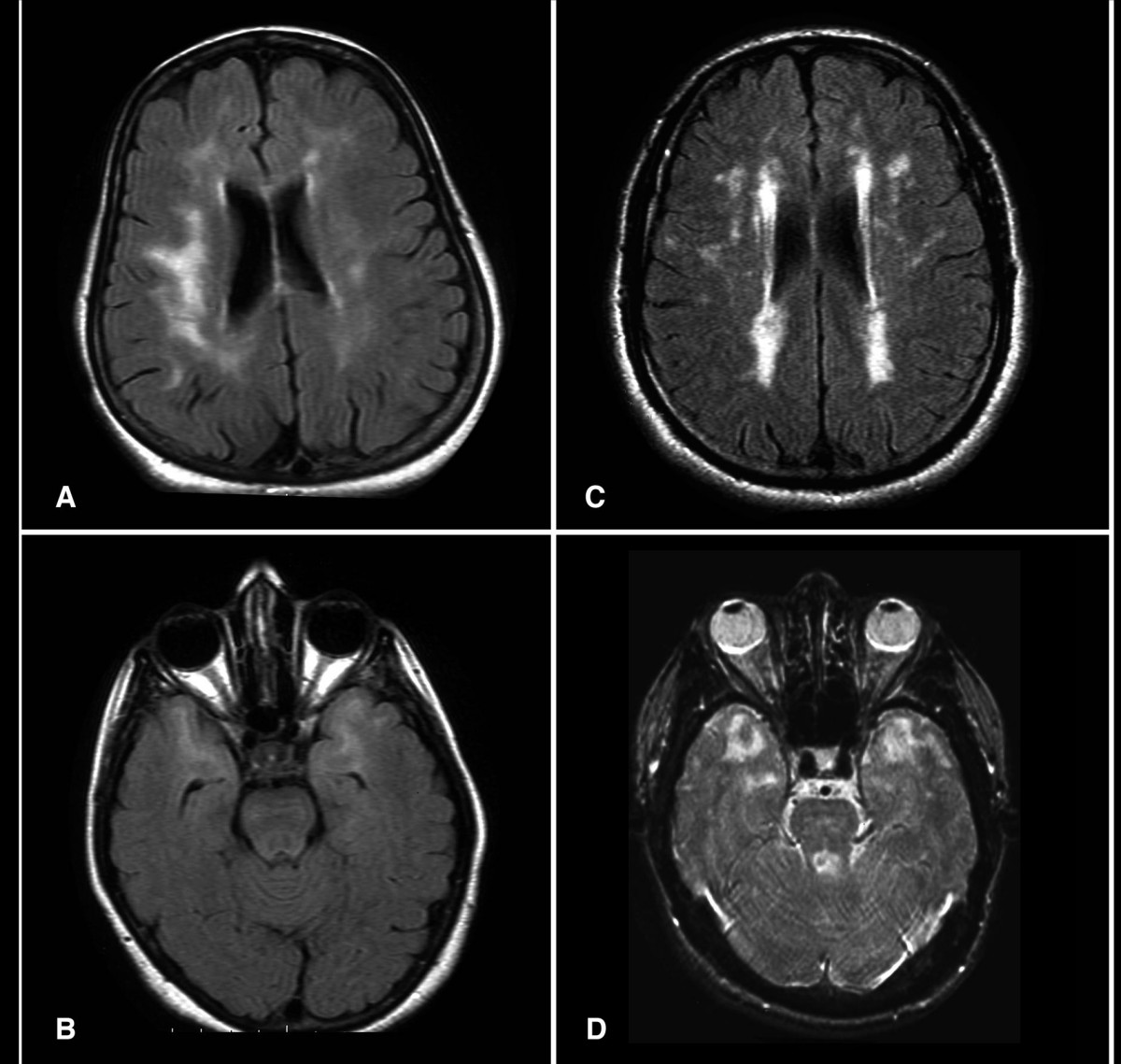CADASIL Syndrome From Wikipedia,
the free encyclopedia.
SSTattler: See as well http://www.cadasilassociation.org/ and www.CADASILfoundation.org ...
 |
| Brain MRI from patients with CADASIL showing multiple lesions. |
Signs and Symptoms
CADASIL may start with attacks of migraine with aura or subcortical transient ischemic attacks or strokes, or mood disorders between 35 to 55 years of age. The disease progresses to subcortical dementia associated with pseudobulbar palsy and urinary incontinence.
Ischemic strokes are the most frequent presentation of CADASIL, with approximately 85% of symptomatic individuals developing transient ischemic attacks or stroke(s). The mean age of onset of ischemic episodes is approximately 46 years (range 30–70). A classic lacunar syndrome occurs in at least two-thirds of affected patients while hemispheric strokes are much less common. It is worthy of note that ischemic strokes typically occur in the absence of traditional cardiovascular risk factors. Recurrent silent strokes, with or without clinical strokes, often lead to cognitive decline and overt subcortical dementia. A case of CADASIL presenting as schizophreniform organic psychosis has been reported.
Pathophysiology
The underlying pathology of CADASIL is progressive degeneration of the smooth muscle cells in blood vessels. Mutations in the Notch 3 gene (on the short arm of chromosome 19) cause an abnormal accumulation of Notch 3 at the cytoplasmic membrane of vascular smooth-muscle cells both in cerebral and extracerebral vessels, seen as granular osmiophilic deposits on electron microscopy.
Diagnosis
 |
| A micrograph showing punctate immunostaining (brown) with a Notch 3 antibody, as is characteristic in CADASIL. |
The definitive test is sequencing the whole Notch 3 gene, which can be done from a sample of blood. However, as this is quite expensive and CADASIL is a systemic arteriopathy, evidence of the mutation can be found in small and medium-size arteries. Therefore, skin biopsies are often used for the diagnosis.
Treatment
No specific treatment is available. However, anti-platelet agents such as aspirin, dipyridamole, or clopidogrel might slow down the disease and help prevent strokes. Given the propensity for cardiovascular and cerebrovascular complications, minimizing vascular risk factors and implementing therapy for primary or secondary prevention of stroke and myocardial infarction seems prudent. Stopping oral contraceptive pills is justified in particular in cases with migraine with aura. Aggressive treatment of hypercholesterolemia and hypertension is reasonable, although the utility of statins and antihypertensive agents in the absence of cardiovascular risk factors is unknown. Homocysteine levels are elevated in CADASIL and treatment with folic acid is reasonable. Anti-platelet therapy appears justifiable, whereas anticoagulation may be inadvisable given the propensity for microhemorrhages, and thus warfarin should be avoided. Administering tPA following onset of stroke is not advised for CADASIL patients, due to increased risk of microhemorrhages.
Some CADASIL patients have used L-Arginine, a naturally occurring amino acid, to ease symptoms such as headache. Aricept, normally used for Alzheimer's Disease, was tested and was shown not to improve executive functioning in CADASIL patients.
In Popular Culture
John Ruskin has been suggested to have suffered from CADASIL Ruskin reported in his diaries having visual disturbances consistent with the disease, and it has also been suggested that it might have been a factor in causing him to describe James Whistler's Nocturne in Black and Gold – The Falling Rocket as "ask[ing] two hundred guineas for throwing a pot of paint in the public's face". This resulted in the famous libel trial that resulted in a jury's awarding Whistler one farthing damages.
Recent research into the illness of philosopher Friedrich Nietzsche has suggested that his mental illness and death were caused by CADASIL rather than tertiary syphilis. Likewise, the early death of the composer Felix Mendelsohn, at age 37, from a stroke has been potentially linked to CADASIL. Mendelsohn's sister was similarly affected.
The character Julia, in the 2004 Spanish film The Sea Inside, has the condition.
See also
See the full article:
CADASIL Syndrome From Wikipedia, the free encyclopedia.

No comments:
Post a Comment